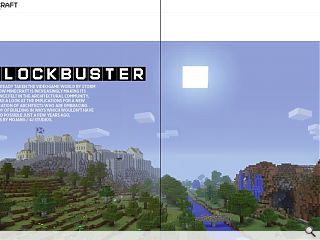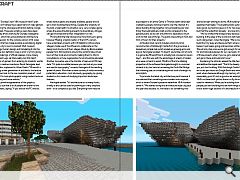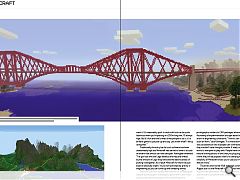Minecraft
15 Apr 2014
It’s already taken the videogame world by storm but now Minecraft is increasingly making its presence felt in the architectural community. We take a look at the implications for a new generation of architects who are embracing the joy of building in ways which wouldn’t have seemed possible just a few years ago. Images by Mojang / 4j Studios.
Construction of Dundee’s new V&A museum hasn’t even begun but that isn’t hampering a select band of video gamers from experiencing the showpiece attraction before a single brick has been laid. These pre-emptive views have been made possible by artists working for Dundee videogame firm 4J Studios, which has just published an architecture inspired ‘texture pack’ for the console version of hit video game Minecraft that has made possible a painstaking digital depiction of the city’s soon-to-be built V&A museum.Taking Kengo Kuma’s design and translating it into the virtual world the low-definition copy is a far-cry from glossy architectural renderings of official releases, more closely resembling a giant Lego set than reality, but this hasn’t deterred millions of gamers from entering its simplistic worlds to flex their own creative muscles as David Keningale, lead artist at 4J Studios, explained to Urban Realm: “Minecraft is already inspiring a new generation of architects, the texture pack has a cleaner look to the low-resolution pixel art – and deliberately so. It’s more photographic using modern textures and is less fantasy and more realistic.”
Despite the primitive appearance of the graphics Keningale points out that a lot of people are drawn to the minimalist aesthetic, saying: “If you look at the PC version, where texture packs are already available, people love to go to town building these things. Despite the simplicity of the look, underneath it’s actually a very, very complex game where the ease of building presents no boundaries. All ages can get involved and let their imagination run riot.”
Proving that the title has become more than just a game however Mojang, original creator of the hit PC version, have undertaken projects with UN Habitat in Africa where villagers made use of the siftware to collaborate on the design and structure of their villages. Block by Block enables people from 300 locations around the world to take virtual tours of their local environments, helping them to inform consultations on how regeneration funds should be allocated. Another innovative use is the transfer of real-world OS map data. “It’s quite incredible because you can look at your area and see the topography,” remarks Keningale of the resulting sprawl of pixels. More than a mere curiosity it holds enormous potential in education, most obviously geography, by giving students a fun means of studying important landscape features.
Keningale added: “It’s architecture on so many fronts, it really is and can be used for planning at a very simplistic level – or as complex as you like. Everything from massive skyscrapers to an entire Game of Thrones realm have been created by people working in teams over the internet. It’s about building things together not just building your own thing. We build relatively small worlds compared to the general public, as we can only afford to dedicate so much work to that side of things. The public are putting in 100s and 100s of hours for their projects.”
4J Studios track record includes a brick-by-brick reconstruction of Edinburgh Castle from the ground up, a deceptively simple task which ended up growing arms and legs as Keningale recalled; “It doesn’t sound like a lot of work in a game like Minecraft but it actually took one person seven days”… and this was with the advantage of a team of coders who were on hand to assist. Mindful of the time dilating properties of the software Keningale brought in a summer student to try her hand at recreating the Forth Rail Bridge the following year, an undertaking which took a fortnight to accomplish.
To promote the latest city architecture pack however it was decided that something more modern was required, which is where Dundee’s putative waterfront V&A museum came in. “We started doing this architectural style city pack this year and decided, no, we need to do something now and we’d been waiting to do the V&A building for a while,” explained Keningale: “The building looks quite blocky so it looks good, we had two guys on it for two weeks and they’ve built half the waterfront already – and are still going.
“We’ve omitted the bridge simply because we started building at the edge of the world and didn’t plan on covering such a large area”, noted Keningale. “We’ve now started to build the City Quay end because that’s where our offices are based, it just keeps going and becomes a little hobby project! We will only stop once we’ve got enough for what we need for promotional purposes for our next pack. It’s definitely one of those projects when if you’ve got a spare half hour you’ll just get in there and build a bit more.”
Explaining the intrinsic appeal the title has for all ages and abilities Keningale said: “That’s the beauty of Minecraft, you just start building. With Edinburgh Castle for example we could spin round on Google Earth and work out what went where because although my memory of the castle is reasonably good it’s not as good as an aerial photograph. The V&A’s not been built yet but there is a fly through that we’ve used for reference. When you’re building from scratch most people just start building and see how things develop. They’ll knock down huge sections of it and rebuild it the way they want it. It’s reasonably quick to work with but can be quite laborious when you’re putting in a 200m long row, 10 storeys high. But it’s fun and that’s what drives people to do it, it’s a brilliant game to just pick up and say, ‘you know what? I fancy doing that.’”
Traditionally the entry bar for such software has been unattainably high but Minecraft has served to lower it to such an extent that almost can now take part. Keningale remarked: “I’ve got kids who are Lego fanatics and they are limited by the amount of Lego they have and the laboriousness of putting it altogether. As a result Minecraft for them has just been an absolute dream. You’re not restricted by gravity or engineering so you can come up with amazing worlds.
Hardcore users are equally well catered for as Mojang are relaxed about people modifying the game with customised code, producing various plug-ins for everything from photographic renders to CAD packages allowing a real flourishing of experimentation brought about by a world shorn of engineering constraints. “I think it can be regarded as an art form,” said Keningale. “It is more technical and very, very accessible so lots of people can contribute in ways that they wouldn’t have thought possible. It really does open the world to everyone to play with. People have created very natural looking blocks of land that you plug together and I think they will be popular, there’s no denying it, but the simplicity of Minecraft forces you to use your imagination a little bit more.”
The bricks and mortar V&A will begin construction this August but it is the Minecraft version which may do more to inspire a new generation of budding architects just as Lego and Meccano did before them, unleashing the inner architect in us all.
|
|
Read next: Freiburg - neighbourhood Watch
Read previous: Derelict Glasgow
Back to April 2014
Browse Features Archive
Search
News
For more news from the industry visit our News section.
Features & Reports
For more information from the industry visit our Features & Reports section.





